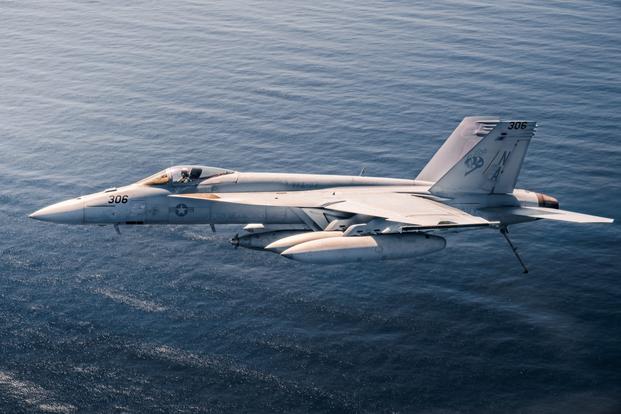A U.S. Navy F/A-18E Super Hornet shot down a Syrian Su-22 on Sunday after the Soviet-era fighter-bomber dropped munitions near U.S.-backed Syrian Democratic Forces fighters, U.S. Central Command officials confirmed.
The strike was believed to be the U.S. military's first air-to-air kill involving manned aircraft in nearly two decades. The last known such instance was when a U.S. Air Force F-16 Fighting Falcon shot down a Serbian MiG-29 in 1999 during the Kosovo campaign.
"A Syrian regime SU-22 dropped bombs near SDF fighters south of Tabqah and, in accordance with rules of engagement and in collective self-defense of Coalition partnered forces, was immediately shot down by a U.S. F/A-18E Super Hornet," the command said in a release.
The attack comes after pro-Syrian forces attacked SDF fighters in Ja'Din, wounding a number of SDF fighters, officials said. The town is south of Tabqah and a known area where U.S. works with Russia to deconflict the airspace.
Related content:
- US F-15E Shoots Down 'Hostile' Predator-Like Drone in Syria
- F-15Es, A-10s Leading Air War Against ISIS
- After Cruise Missile Strike, F-22s Still Safe to Patrol Syrian Skies
"Coalition aircraft conducted a show of force and stopped the initial pro-regime advance toward the SDF-controlled town," the release said.
Following the advance on the SDF, the coalition alerted Russian counterparts to de-escalate the situation. However the forces -- backed by President Bashar al-Assad -- did not appear to back down, with the Su-22 entering the area, CentCom said.
"The coalition does not seek to fight Syrian regime, Russian, or pro-regime forces partnered with them, but will not hesitate to defend coalition or partner forces from any threat," the command said.
While Central Command said its mission is to defeat the Islamic State of Iraq and Syria, or ISIS, the strike against the pro-Syrian regime forces marks the fourth strike in recent weeks by the coalition.
Drone Shootdown
Most recently, a U.S. F-15E on June 8 shot down an unidentified drone deemed hostile toward coalition forces in At Tanf.
The drone, similar in size to a U.S. MQ-1 Predator, was suspected to be "pro-regime" and was struck down after it was observed dropping a munition near coalition personnel training partner forces in the fight against the Islamic State, according to Operation Inherent Resolve spokesman Army Col. Ryan Dillon.
The drone strike marked the first time that forces supporting the Syrian government have attacked inside a so-called "deconfliction" zone near At Tanf, close to the Jordanian border, Dillon said.
Defense Secretary Jim Mattis has said the pro-Syrian forces are backed by Iran, and have been knowingly operating "inside an established and agreed-upon deconfliction zone." They are believed to be a threat to coalition forces in the region, he has said.
The deconfliction zone is an area in which U.S. and Russian forces have agreed not to operate. The zone previously applied to airspace but now includes ground territory, a defense official told Military.com last month.
First Kill
The last air-to-air kill for the F/A-18 was during the Gulf War when two F/A-18s shot down two Iraqi MiG-21s during a brief dogfight. The kill over Syria, however, is believed to be the first air-to-air kill for the E model.
The F/A-18s are flying the most combat missions in Operation Inherent Resolve, the Pentagon's name for operations against the Islamic State, according to recent statistics provided to Military.com.
Meanwhile, the Syrian Su-22 -- a variant of the Sukhoi 17 and Su-20 and heavily used throughout the Arab-Israeli conflicts and the 1982 Lebanon War -- have been involved in the Assad's Syrian war since roughly mid-2012.
The Su-22s were believed to be the aircraft behind the nerve agent attack in April against the town of Khan Sheikhoun in northwestern Syria's Idlib governorate.
Days later, President Donald Trump ordered two Navy destroyers to launch more than 50 Tomahawk missiles on Al Shayrat base north of Damascus, where the SU-22s launched from.
-- Oriana Pawlyk can be reached at oriana.pawlyk@military.com. Follow her on Twitter at @Oriana0214.


























